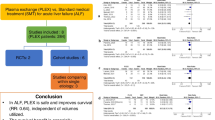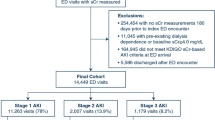Abstract
Objectives
To investigate the predictors of platelet increment and risk factors for major complications after partial splenic embolization (PSE) in cirrhosis.
Methods
Between March 2010 and June 2012, 52 cirrhotic patients with severe thrombocytopenia underwent PSE. Multiple variables were analyzed to identify the correlated factors affecting platelet increment and major complications after PSE.
Results
Linear mixed model analysis indicated the splenic infarction ratio (P < 0.001), non-infarcted splenic volume (P = 0.012), and cholinesterase level (P < 0.001) were significantly associated with the platelet increment after PSE. In receiver operating characteristic (ROC) analysis, the cut-off values of the splenic infarction ratio, and non-infarcted splenic volume for achieving an increment of ≥60.0 × 109/L in platelet counts at 1 year after PSE were 64.3 % and 245.8 mL, respectively. After PSE, eight patients developed major complications. Multivariate logistic regression analysis indicated major complications were significantly associated with the infarcted splenic volume (P = 0.024) and Child-Pugh score (P = 0.018). In ROC analysis, the cut-off values of these two factors for discriminating the uncomplicated and complicated were 513.1 mL and 9.5, respectively.
Conclusions
The platelet increment after PSE depends on the splenic infarction ratio, non-infarcted splenic volume and cholinesterase level. But a large infarcted splenic volume and a high Child-Pugh score may cause complications.
Key Points
• The platelet increment after PSE greatly depends on the splenic infarction ratio.
• The non-infarcted splenic volume significantly affects the efficacy of PSE.
• A high cholinesterase level contributes to the improvement of thrombocytopenia after PSE.
• The non-infarcted splenic volume significantly affects the relapse of hypersplenism.
• Complications are significantly associated with the infarcted splenic volume and Child-Pugh score.




Similar content being viewed by others
Abbreviations
- PSE:
-
Partial splenic embolization
- TPO:
-
Thrombopoietin
- CT:
-
Computed tomography
- ROC:
-
Receiver operating characteristic
- AST:
-
Aspartate aminotransferase
- ALT:
-
Alanine aminotransferase
- CI:
-
Confidence interval
- OR:
-
Odds ratio
- β :
-
Standardized regression coefficient
References
Poordad F (2007) Review article: thrombocytopenia in chronic liver disease. Aliment Pharmacol Ther 26:5–11
Afdhal N, McHutchison J, Brown R et al (2008) Thrombocytopenia associated with chronic liver disease. J Hepatol 48:1000–1007
Fouad YM (2013) Chronic hepatitis C-associated thrombocytopenia: aetiology and management. Trop Gastroenterol 34:58–67
Sangro B, Bilbao I, Herrero I et al (1993) Partial splenic embolization for the treatment of hypersplenism in cirrhosis. Hepatology 18:309–314
Zhu K, Meng X, Li Z et al (2008) Partial splenic embolization using polyvinyl alcohol particles for hypersplenism in cirrhosis: a prospective randomized study. Eur J Radiol 66:100–106
Zhu K, Meng X, Qian J et al (2009) Partial splenic embolization for hypersplenism in cirrhosis: a long-term outcome in 62 patients. Dig Liver Dis 41:411–416
Amin MA, El-Gendy MM, Dawoud IE, Shoma A, Negm AM, Amer TA (2009) Partial splenic embolization versus splenectomy for the management of hypersplenism in cirrhotic patients. World J Surg 33:1702–1710
Palsson B, Verbaan H (2005) Partial splenic embolization as pretreatment for antiviral therapy in hepatitis C virus infection. Eur J Gastroenterol Hepatol 17:1153–1155
Noguchi H, Hirai K, Aoki Y, Sakata K, Tanikawa K (1995) Changes in platelet kinetics after a partial splenic arterial embolization in cirrhotic patients with hypersplenism. Hepatology 22:1682–1688
Hayashi H, Beppu T, Masuda T et al (2007) Predictive factors for platelet increase after partial splenic embolization in liver cirrhosis patients. J Gastroenterol Hepatol 22:1638–1642
Hayashi H, Beppu T, Okabe K et al (2010) Therapeutic factors considered according to the preoperative splenic volume for a prolonged increase in platelet count after partial splenic embolization for liver cirrhosis. J Gastroenterol 45:554–559
N'Kontchou G, Seror O, Bourcier V et al (2005) Partial splenic embolization in patients with cirrhosis: efficacy, tolerance and long-term outcome in 32 patients. Eur J Gastroenterol Hepatol 17:179–184
Vujic I, Lauver JW (1981) Severe complications from partial splenic embolization in patients with liver failure. Br J Radiol 54:492–495
Sakai T, Shiraki K, Inoue H et al (2002) Complications of partial splenic embolization in cirrhotic patients. Dig Dis Sci 47:388–391
Hayashi H, Beppu T, Okabe K, Masuda T, Okabe H, Baba H (2008) Risk factors for complications after partial splenic embolization for liver cirrhosis. Br J Surg 95:744–750
Cai M, Zhu K, Huang W et al (2013) Portal vein thrombosis after partial splenic embolization in liver cirrhosis: efficacy of anticoagulation and long-term follow-up. J Vasc Interv Radiol 24:1808–1816
Alwmark A, Bengmark S, Gullstrand P, Joelsson B, Lunderquist A, Owman T (1982) Evaluation of splenic embolization in patients with portal hypertension and hypersplenism. Ann Surg 196:518–524
Koizumi J, Itou C, Wray R et al (2013) Partial splenic embolisation using n-butyl cyanoacrylate: intraprocedural evaluation by magnetic resonance imaging. Eur Radiol 23:1429–1442
Hidaka H, Kokubu S, Saigenji K, Isobe Y, Maeda T (2002) Restoration of thrombopoietin production after partial splenic embolization leads to resolution of thrombocytopenia in liver cirrhosis. Hepatol Res 23:265
Angle JF, Siddiqi NH, Wallace MJ et al (2010) Quality improvement guidelines for percutaneous transcatheter embolization: Society of Interventional Radiology Standards of Practice Committee. J Vasc Interv Radiol 21:1479–1486
Meng F, Yin X, Ma X, Guo XD, Jin B, Li H (2013) Assessment of the value of serum cholinesterase as a liver function test for cirrhotic patients. Biomed Rep 1:265–268
Acknowledgments
The scientific guarantor of this publication is Kangshun Zhu (Deputy director of Radiology Department, the Third Affiliated Hospital, and Interventional Radiology Institute, Sun Yat-sen University). The authors of this manuscript declare no relationships with any companies, whose products or services may be related to the subject matter of the article. This study has received funding by the National Natural Science Foundation of China (Grant No. 81371655), Science and Technology Planning Project of Guangdong Province, China (Grant No. 2010B031600211), and Science and Technology Planning Project of Guangzhou, Guangdong Province, China (Grant No. 2013 J4100118). Xingxuan Wen (Department of Biostatistics and Epidemiology, School of Public Health, Sun Yat-Sen University) kindly provided statistical advice for this manuscript. Institutional Review Board approval was obtained. Written informed consent was obtained from all subjects (patients) in this study. Methodology: prospective, diagnostic or prognostic study / observational, performed at one institution.
Author information
Authors and Affiliations
Corresponding author
Additional information
Mingyue Cai, Wensou Huang and Chaoshuang Lin contributed equally to this work.
Rights and permissions
About this article
Cite this article
Cai, M., Huang, W., Lin, C. et al. Partial splenic embolization for thrombocytopenia in liver cirrhosis: predictive factors for platelet increment and risk factors for major complications. Eur Radiol 26, 370–380 (2016). https://doi.org/10.1007/s00330-015-3839-4
Received:
Revised:
Accepted:
Published:
Issue Date:
DOI: https://doi.org/10.1007/s00330-015-3839-4




